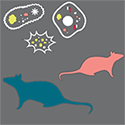Online Training Modules:
Integrating Sex & Gender in Health Research

Did you know…
Chronic pain hypersensitivity is mediated by microglial cells in male mice and by T-cells in female mice?1
Could you be missing an important sex difference by excluding female cells and animals from your research?The X-chromosome has 1,669 genes and the Y-chromosome only 426. Only 33% of Genome Wide Association Studies include the X-chromosome.2
Does that make sense?Many funding organizations around the world require the integration of sex/gender considerations at all stages of the research process.3
Will your research be left behind?

Course 2: Sex and Gender in Primary Data Collection with Human Participants
Start course More InformationDid you know…
- Different recruitment strategies may be required to obtain equal numbers of women and men in clinical trials and to enrol sufficient men in qualitative research studies.
Are you addressing these challenges in the methodology section of your protocol? - Self-reported data in studies may change depending on whether interviews are conducted by male or female researchers.
Have you considered ways to avoid gender bias in your research? - More and more scientific journals are changing their editorial policies to require that the sex and/or gender of research cells, tissues, animals and human participants be reported.4
Could not accounting for sex or gender make it more difficult for you to publish?

Course 3: Sex and Gender in the Analysis of Secondary Data from Human Participants
Start course More InformationDid you know…
- In a recent study, investigators found that gender, independent of sex, predicts poor outcomes of early heart disease.
5
6
7
Do you include gender considerations, in addition to sex considerations, in your analysis of health outcomes? - More men work in goods-producing sectors such as construction and manufacturing, while more women work in service sectors such as health care and caregiving.
8
How might the gendered nature of work impact health outcomes for men and women? - Research suggests that men are more likely to be injured at work; however, women who work in shifts have higher rates of work-related injury than men.9
How might gender roles influence workplace health and safety research?
Take these training course to learn how to:
- Distinguish between and define sex and gender in health research;
- Identify sex and gender differences in the mechanism, disease or treatment under study;
- Identify methods for integrating sex and gender variables in health research contexts; and
- Assess a research protocol or publication based on the integration or omission of sex and/or gender.
Other learning resources
- Learning about Sex and Gender – Video
- What is Gender? What is Sex?
- Sex and Gender in Health Research Guide: A Tool for CIHR Applicants
- Sex, Gender and Knowledge Translation
- The Ethical Imperative of Sex and Gender Considerations in Health Research
- Sex/Gender-Responsive Assessment Scale for Health Research
- Checklist for Integrating Sex and Gender in Biomedical Research
- Checklist for Integrating Sex and Gender in Research with Human Participants
- Resources for applicants to the Canadian Microbiome Initiative 2: A Focus on function and translation
Footnotes
- Footnote 1
-
Sorge RE, Mapplebeck JC, Rosen S et al. Different immune cells mediate mechanical pain hypersensitivity in male and female mice. Nat Neurosci. 2015; 18:1081-1083.
- Footnote 2
-
Wise AL, Gyi L, Manolio TA. eXclusion: Toward integrating the X chromosome in Genome-wide association analysis. Am J Hum Genet. 2013;92: 643-647.
- Footnote 3
-
Tannenbaum C, Schwarz JM, Clayton JA, de Vries G, Sullivan C. Evaluating sex as a biological variable in preclinical research: the devil in the details. Biol Sex Differ. 2016;7(13).
- Footnote 4
-
Del Boca FK. Addressing sex and gender inequities in scientific research and publishing [published online February 29 2016]. Addiction. 2016. doi: 10.1111/add.13269.
- Footnote 5
-
Pelletier R, Khan NA, Cox J, et al. Sex Versus Gender-Related Characteristics: Which Predicts Outcome After Acute Coronary Syndrome in the Young?. J Am Coll Cardiol. 2016;67(2):127-135. doi:10.1016/j.jacc.2015.10.067.
- Footnote 6
-
Spence JD, Pilote L. Importance of sex and gender in atherosclerosis and cardiovascular disease. Atherosclerosis. 2015;241(1):208-10. doi:10.1016/j.atherosclerosis.2015.04.806.
- Footnote 7
-
Pelletier R, Ditto B, Pilote L. A composite measure of gender and its association with risk factors in patients with premature acute coronary syndrome. Psychosom Med. 2015;77(5):517-26. doi: 10.1097/PSY.0000000000000186.
- Footnote 8
-
Employment by industry and sex, CANSIM table 282-0008, 2015. Statistics Canada. http://www.statcan.gc.ca. Updated January 28, 2015. Accessed April 4, 2016.
- Footnote 9
-
Mustard CA, Chambers A, McLeod C, Bielecky A, Smith PM. Work injury risk by time of day in two population-based data sources. Occupational and Environmental Medicine 2013;70(1):49-56. doi:10.1136/oemed-2012-100920.
- Date modified:
